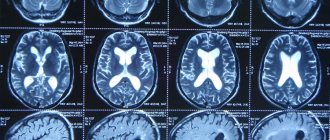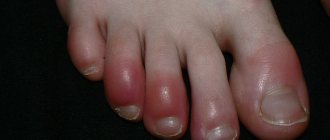An occasional headache is familiar to all people, since it can appear as a consequence of ordinary fatigue or the body’s reaction to changes in meteorological conditions. Usually this condition does not require medical intervention and stops on its own, you just need to rest a little or wait for the weather to change. However, constant pain in the temples, forehead or eyes this is a clear reason to think about your own health, since regular headaches (chronic cephalgia) can be one of the symptoms of a serious illness.
Manifestations of headache and accompanying symptoms
We call any pain in the head area a headache, but the mechanism of its occurrence varies. It is caused by irritation of pain receptors in the dura mater, as well as blood vessels, nerves - trigeminal, glossopharyngeal, vagus, skin nerves, head muscles, cervical spinal roots. It can also manifest itself in different ways: it can be dull, pulsating, squeezing, bursting; can concentrate in the forehead, temples (on one or both sides), back of the head, crown of the head. Attacks can be strong, moderate or weak, and vary in duration and frequency. Pain may be accompanied by other symptoms (nausea, vomiting, visual disturbances, dizziness, increased or decreased blood pressure, etc.). All these characteristics are important for making a diagnosis.
Pathologies of the nervous system
Migraine
This is a common disease that most often affects women. A distinctive feature of migraine is its localization and pulsating nature.
Migraine usually begins with pain in the temple, which is one-sided, and the headache is often localized in the occipital region. In most cases, pain is aggravated by sounds of any volume, bright light, or vibrations.
Sometimes attacks are triggered by certain foods rich in serotonin, such as red wine, cheese, fish and chocolate.
Causes of headaches
There are primary and secondary headaches. Primary pain is considered to be pain that is not an accompanying symptom, but is an independent disease. In this case, it is the headache that is the main problem. Secondary headache is one of the manifestations of a disease that is not limited to headache. Severe headaches can be accompanied by infectious diseases and poisoning of various natures (both toxic substances entering the body from the outside and those produced inside the body, for example, toxins that are formed as a result of the activity of viruses and pathogenic microbes in the body). A headache can occur as a result of stress, weather changes, hypothermia or overheating of the body, lack of sleep, hunger, overeating, lack of oxygen - the cause can be anything that leads to disruption of the metabolism necessary for brain activity.
So, if you have a headache, it does not necessarily mean that you are sick: it may simply be the result of a random factor. However, if the headache occurs periodically or persists for a long time, then most likely there is some kind of disease. In 95% of such cases, there is a primary headache, and only in 5% of cases is it secondary.
Primary headache. Major diseases.
The most common forms of primary headache are “tension pain” and migraine, more rarely – cluster headache and other forms.
Tension headache (TTH)
can occur in anyone. This is the most common form of headache and is often characterized as a “normal” or “regular” headache. Attacks can last from 30 minutes to several days. The frequency of attacks varies from person to person, and it can also vary from one person to another during different periods of his life. The pain is described as squeezing, squeezing the head like a hoop or tight hat, usually bilateral, and moderate. In some people it can become chronic (chronic pain is diagnosed if there are more days with a headache than without it). A person experiencing chronic headaches becomes irritable. Weakness, fatigue, decreased appetite, and sleep disturbances may occur. The cause of TTH is physical tension in the muscles and ligaments of the head and neck - the so-called “muscle stress”, which can be a consequence, for example, of working in an uncomfortable position. TTH often occurs in those who work at a computer or whose work involves the need to look at details (jewelers, watchmakers, assemblers of electronic equipment, masters of artistic embroidery, etc.). The emotional factor is also important: emotional tension caused by stress or a state of increased anxiety can also lead to pain.
Migraine
characterized by severe and painful attacks of headache, which are often accompanied by nausea (and in some cases vomiting), as well as intolerance to light and sound. The perception of smells changes, thermal sensations are disrupted. Migraine attacks last from 4 hours to 3 days and can be repeated with a frequency of 1-2 times a year to several times a month. During an attack, so-called “precursors” may be observed - irritability, depression, fatigue, occurring several hours or even days before the onset of pain. In a third of cases, pain is preceded by phenomena called “auras”: 10-30 minutes before the attack there may be visual disturbances (blind spots, flashes, zigzag lines in front of the eyes), tingling and numbness starting from the fingertips and spreading up the body and etc.
Predisposition to migraine is congenital and is associated with disorders in the brain structures responsible for pain and other sensations. Every seventh adult suffers from migraines, with women three times more likely than men. In girls, migraines usually begin during puberty.
Factors that contribute to the development of migraine attacks: chronic fatigue, anxiety or stress, in women - menstruation, pregnancy and menopause.
But a predisposition to seizures does not mean that an attack will definitely happen. There are factors that act as a “trigger” for an attack. An attack can be triggered by: skipping meals, insufficient fluid intake, certain foods, sleep disturbances, physical activity, changes in weather, sudden changes in emotions.
Cluster (or beam) headache
characterized by one-sided sharp (“dagger” or “drilling”) pain. The intensity of the pain rapidly increases within 5-10 minutes, and the attack itself lasts from 15 minutes to 3 hours, during which the patient cannot find a place to rest. The pain is usually localized in the eye area, and the eye may become red and watery. Recurrent attacks form a cluster (that is, they follow each other), the duration of the cluster is from 6 to 12 weeks. This form of pain occurs five times more often in men than in women. However, those who smoke a lot or have smoked in the past are more susceptible to it.
Treatment
Restorative procedures depend on the underlying cause of the pain. For chronic fatigue and overstrain, quality rest and a change of environment, fresh air, and taking natural sedatives are recommended. Inflammations and infections require targeted treatment with medications, including antibiotics. Problems with the cervical spine are solved by massage, exercise therapy, and physiotherapy. Cystic and tumor processes are considered individually, the issue of surgical treatment with removal of the pathological object is decided.
Secondary headache and diseases in which it occurs
In general, primary headache, although it disrupts the normal course of life during attacks, does not have serious consequences for a person’s general health. And secondary pain, despite the fact that it occurs much less frequently (in 5% of cases), can be a consequence of a dangerous disease.
Headache is necessarily present among the symptoms of the following diseases:
- vegetative-vascular dystonia (headaches can be combined with dizziness, nausea, fluctuations in blood pressure);
- hypertension (pain is mainly localized in the occipital region, there may be dizziness, noise in the head, spots before the eyes, heat in the head, pain in the heart);
- stroke;
- traumatic brain injury;
- meningitis;
- encephalitis;
- eye diseases (for example, glaucoma);
- diseases of the ear and nasopharynx (otitis media, sinusitis);
- neuralgia;
- diabetes;
- renal failure;
- oncological diseases.
Diagnostics
Neurologists at the Yusupov Hospital conduct a comprehensive examination of patients. It allows you to determine the exact cause of the headache. Patients are prescribed the following studies:
- Computer and magnetic resonance imaging of the brain;
- Ultrasound Doppler examination of the vessels of the head and neck;
- Electroencephalography;
- Echoencephalography;
- REO-encephalography.
The doctor recommends that the patient keep a headache diary in which he needs to record the following information:
- When did the pain occur?
- What is its intensity;
- How long did the attack last?
- Has your blood pressure risen?
The patient brings the diary to an appointment with a neurologist. The doctor analyzes the information provided by the patient, the results of the studies performed and develops tactics for managing the patient.
When should you see a doctor for a headache?
Many people prefer to simply take popular painkillers and not see a doctor. However, self-medication can lead to excessive use of such drugs, which can cause gastritis, peptic ulcers, as well as chronic headaches caused by taking medications. In addition, without undergoing a medical examination, you may miss the development of a dangerous disease. And a momentary effect obtained with the help of a random drug will still not be a solution to your problem.
You should definitely consult a doctor:
- if pain occurs for the first time in life (especially important for people over 50 years old);
- with very severe headaches;
- if the pain continues for a significant time (more than a week);
- if the pain intensity increases over time;
- when a headache occurs or worsens after a change in position or sudden movement of the head;
- if there are cases of loss of consciousness, memory impairment, changes in personal qualities;
- if the pain does not go away after taking antipyretic and painkillers.
Which doctor should you see if you have a headache?
If you complain of a headache, you should first contact your physician. To make it easier for the doctor to understand your disease, it is advisable to prepare answers to the following questions before visiting the doctor:
- How long has the pain been present?
- How often do the attacks recur?
- How long do they last?
- How severe is your pain (mild, moderate, severe, intolerable)?
- What is its character (pressing, bursting, pulsating)?
- In what part of the head is the pain concentrated?
- Are there any accompanying symptoms and what are they?
- At what point does pain occur (what contributes to its occurrence)?
- Do you manage to relieve pain (prevent attacks) and how do you do it?
- Do your relatives have similar complaints?
Infections
Pain can occur with a variety of infections, including influenza and common ARVI. In this case, it is usually accompanied by high fever.
The most serious complications of the infectious process that cause headaches are meningitis and encephalitis.
Meningitis
Meningitis is an inflammatory process in the lining of the brain that occurs due to bacteria or viruses. It can also develop as a complication after a head injury.
In addition to pain, nausea, fever, stiffness of the neck and neck muscles, convulsions and disturbances of consciousness are characteristic. It is diagnosed by a combination of symptoms, including the results obtained from the study of cerebrospinal fluid.
Doctor's advice
With such a symptom as a headache, the following are important in diagnosis: 1. General blood test - helps to determine the nature of the pathogen (viral, infectious) and to suspect oncopathology. 2. MRI of the brain - visualizes the structures of all departments, identifies pathological foci, increased intracranial pressure. 3. X-ray/MRI of the cervical spine - shows problems at this level, which can cause bloat syndrome. 4. Ultrasound of the vessels of the neck - necessary if there is a suspicion of a violation of the venous outflow from the head, a decrease in the flow of blood to the brain. 5. Ultrasound or MRI of cerebral vessels - carried out to identify abnormalities in the structure of blood vessels, narrowing their diameter.
Victoria Druzhikina Neurologist, Therapist
Encephalitis
Encephalitis is a dangerous viral disease. Its manifestations are similar to meningitis - headache, fever, increased sensitivity of the eyes to light.
The best known is tick-borne encephalitis, which can be contracted after the bite of a tick that carries the virus. In areas where the virus is widespread, outbreaks usually occur in the spring.








